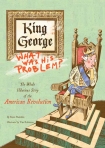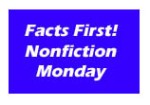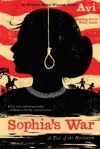 King George: What Was His Problem? The Whole Hilarious Story of the American Revolution. Written by Steve Sheinkin. Illustrated by Tim Robinson. Square Fish (an imprint of MacMillan Publishers), 2009. 208 pages. Publisher recommends for ages 10 and older. ISBN: 9781596435186.
King George: What Was His Problem? The Whole Hilarious Story of the American Revolution. Written by Steve Sheinkin. Illustrated by Tim Robinson. Square Fish (an imprint of MacMillan Publishers), 2009. 208 pages. Publisher recommends for ages 10 and older. ISBN: 9781596435186.
Sheinkin tells the story of the American Revolution in a fun and funny way. He uses anecdotes and stories that don’t make it into history textbooks, for example he writes about the night Benjamin Franklin and John Adams shared a bed. That night Adams wanted to close the window in the room because he was afraid of catching a cold. Franklin told him to leave the window open or they would suffocate and launched into a lecture about what causes colds, a lecture that soon put Adams to sleep. In that story, Franklin and Adams become real people, not just names to memorize.
The book is made up of short chapters that cut back and forth between battles in the North and battles in the South. The chapters also cut between the political actions of the American Congress and the war. And we see Benjamin Franklin beseeching the French government to enter the war on behalf of the Americans. We also find out that when Franklin arrived in France the British were afraid he would stretch a chain from Calais to Dover and administer an electric shock to Britain that would be strong enough to overturn the island (this anecdote had me laughing out loud).
In the very beginning of the war, at the battle in Lexington, the reader sees both the British commander and the American commander telling their troops not to fire. Yet someone fired. Both sides said it was the other side. “So no one takes credit for ‘the shot heard round the world’ — the first shot of the American Revolution.” Throughout the book Sheinkin includes both the American and the British perspective in this way.
The irony of the Declaration of Independence declaring all men are free and endowed with unalienable rights, while many of the signers owned slaves, is addressed in a short chapter.
Many, many quotes are used and it’s fun to see who said what.
At the back of the book there is extensive reference material.
The details keep the narrative moving, but by the end of the book I was impressed by my increased understanding of the timeline of the Revolution. Sheinkin is paying attention to the big picture as well as the details.
I had a great time reading this book. I also learned (or maybe re-learned) a great deal about the American Revolution.
Blog Reviews:
Becky’s Book Blog
Bookfoolery
A Fuse #8 Production
I.N.K.
The Literate Mother
Red Hot Eyebrows
Professional Reviews:
It’s Nonfiction Monday!



